Nursing 11: Summative Assessment on Student Nurse Reporting Factors
VerifiedAdded on 2022/09/01
|15
|4180
|14
Report
AI Summary
This report provides a critical evaluation of a qualitative research article titled 'Factors influencing student nurse decisions to report poor practice witnessed while on placement.' The assignment analyzes the article's methodology, including its qualitative research design, phenomenological underpinning, and convenience sampling method. It examines the credibility of the authors, the robustness of the research problem, the literature review's comprehensiveness, and the ethical considerations. The report highlights the importance of clinical placements in nursing education and the impact of student nurses' decisions on patient safety and global health initiatives. It also discusses the advantages and disadvantages of qualitative research and convenience sampling, as well as the ethical considerations involved. The report concludes by summarizing the key findings and implications of the research for nursing practice and education.
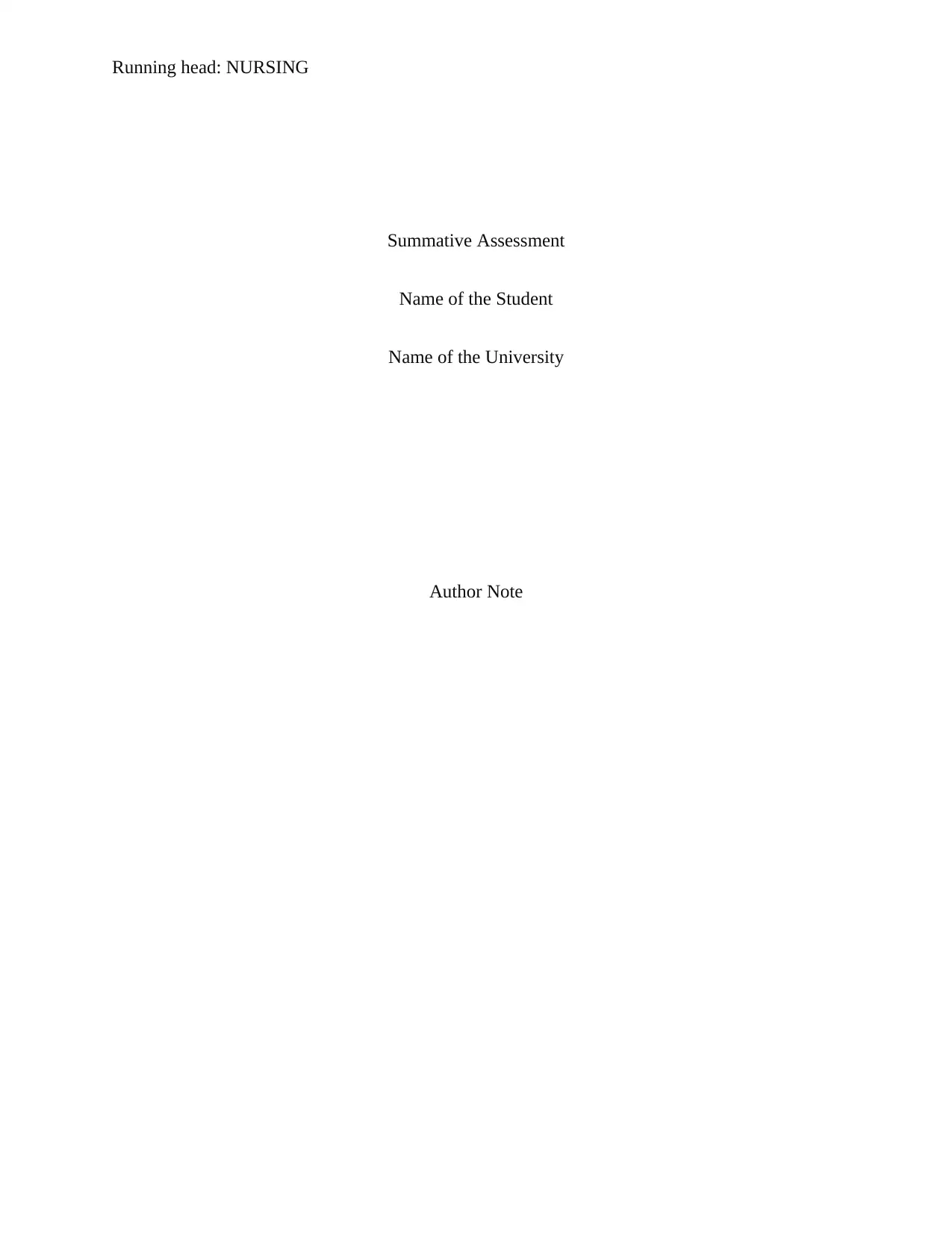
Running head: NURSING
Summative Assessment
Name of the Student
Name of the University
Author Note
Summative Assessment
Name of the Student
Name of the University
Author Note
Paraphrase This Document
Need a fresh take? Get an instant paraphrase of this document with our AI Paraphraser
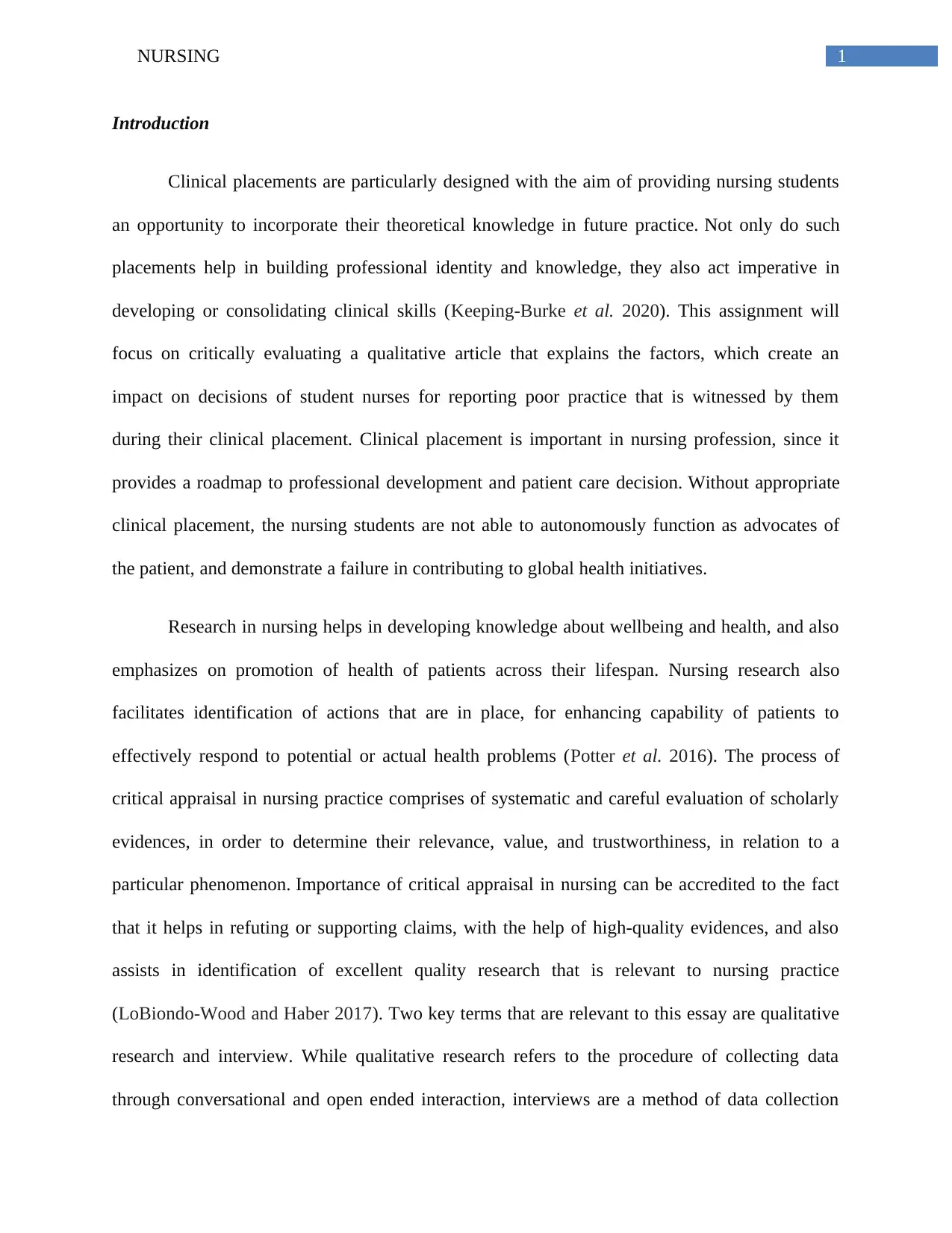
1NURSING
Introduction
Clinical placements are particularly designed with the aim of providing nursing students
an opportunity to incorporate their theoretical knowledge in future practice. Not only do such
placements help in building professional identity and knowledge, they also act imperative in
developing or consolidating clinical skills (Keeping-Burke et al. 2020). This assignment will
focus on critically evaluating a qualitative article that explains the factors, which create an
impact on decisions of student nurses for reporting poor practice that is witnessed by them
during their clinical placement. Clinical placement is important in nursing profession, since it
provides a roadmap to professional development and patient care decision. Without appropriate
clinical placement, the nursing students are not able to autonomously function as advocates of
the patient, and demonstrate a failure in contributing to global health initiatives.
Research in nursing helps in developing knowledge about wellbeing and health, and also
emphasizes on promotion of health of patients across their lifespan. Nursing research also
facilitates identification of actions that are in place, for enhancing capability of patients to
effectively respond to potential or actual health problems (Potter et al. 2016). The process of
critical appraisal in nursing practice comprises of systematic and careful evaluation of scholarly
evidences, in order to determine their relevance, value, and trustworthiness, in relation to a
particular phenomenon. Importance of critical appraisal in nursing can be accredited to the fact
that it helps in refuting or supporting claims, with the help of high-quality evidences, and also
assists in identification of excellent quality research that is relevant to nursing practice
(LoBiondo-Wood and Haber 2017). Two key terms that are relevant to this essay are qualitative
research and interview. While qualitative research refers to the procedure of collecting data
through conversational and open ended interaction, interviews are a method of data collection
Introduction
Clinical placements are particularly designed with the aim of providing nursing students
an opportunity to incorporate their theoretical knowledge in future practice. Not only do such
placements help in building professional identity and knowledge, they also act imperative in
developing or consolidating clinical skills (Keeping-Burke et al. 2020). This assignment will
focus on critically evaluating a qualitative article that explains the factors, which create an
impact on decisions of student nurses for reporting poor practice that is witnessed by them
during their clinical placement. Clinical placement is important in nursing profession, since it
provides a roadmap to professional development and patient care decision. Without appropriate
clinical placement, the nursing students are not able to autonomously function as advocates of
the patient, and demonstrate a failure in contributing to global health initiatives.
Research in nursing helps in developing knowledge about wellbeing and health, and also
emphasizes on promotion of health of patients across their lifespan. Nursing research also
facilitates identification of actions that are in place, for enhancing capability of patients to
effectively respond to potential or actual health problems (Potter et al. 2016). The process of
critical appraisal in nursing practice comprises of systematic and careful evaluation of scholarly
evidences, in order to determine their relevance, value, and trustworthiness, in relation to a
particular phenomenon. Importance of critical appraisal in nursing can be accredited to the fact
that it helps in refuting or supporting claims, with the help of high-quality evidences, and also
assists in identification of excellent quality research that is relevant to nursing practice
(LoBiondo-Wood and Haber 2017). Two key terms that are relevant to this essay are qualitative
research and interview. While qualitative research refers to the procedure of collecting data
through conversational and open ended interaction, interviews are a method of data collection
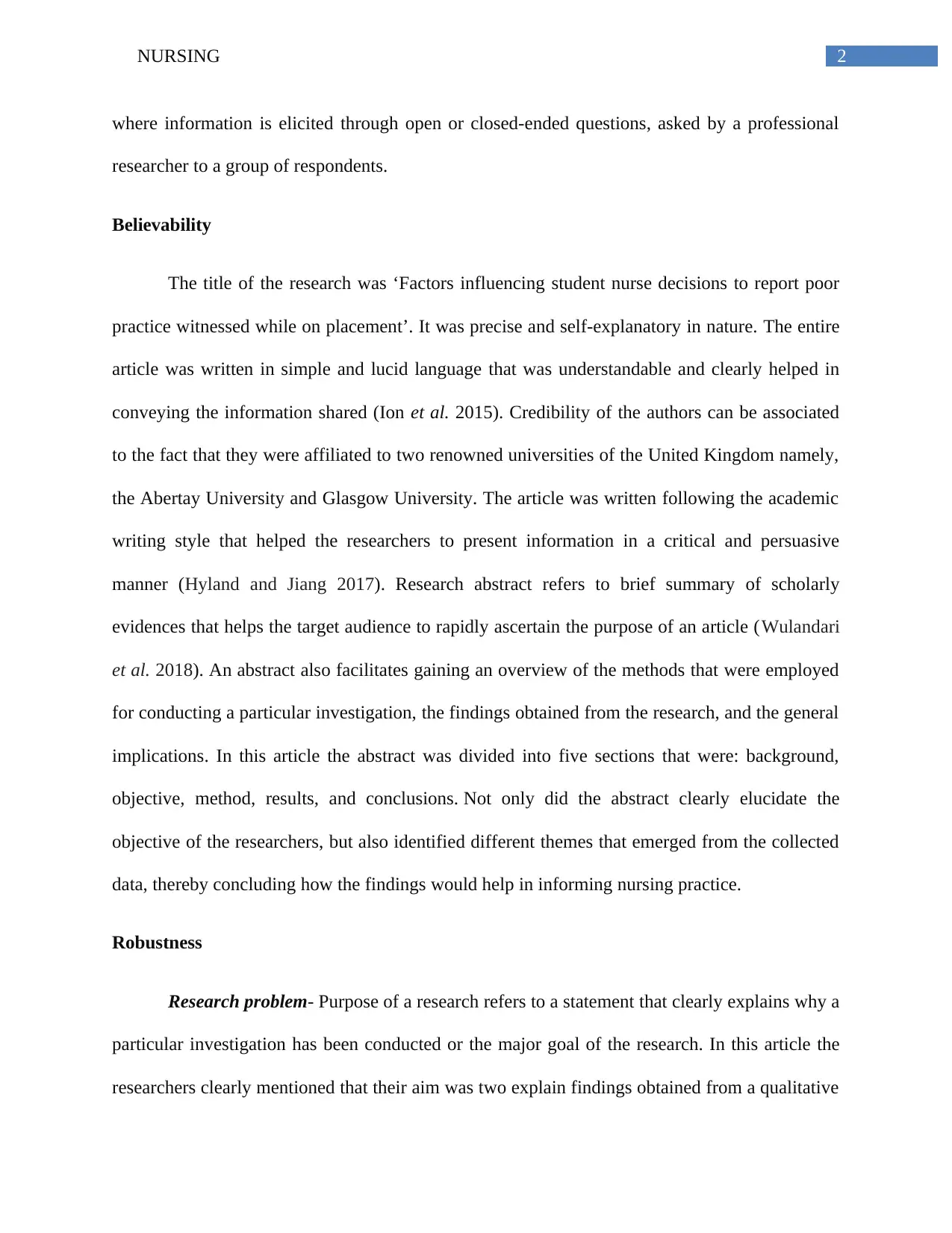
2NURSING
where information is elicited through open or closed-ended questions, asked by a professional
researcher to a group of respondents.
Believability
The title of the research was ‘Factors influencing student nurse decisions to report poor
practice witnessed while on placement’. It was precise and self-explanatory in nature. The entire
article was written in simple and lucid language that was understandable and clearly helped in
conveying the information shared (Ion et al. 2015). Credibility of the authors can be associated
to the fact that they were affiliated to two renowned universities of the United Kingdom namely,
the Abertay University and Glasgow University. The article was written following the academic
writing style that helped the researchers to present information in a critical and persuasive
manner (Hyland and Jiang 2017). Research abstract refers to brief summary of scholarly
evidences that helps the target audience to rapidly ascertain the purpose of an article (Wulandari
et al. 2018). An abstract also facilitates gaining an overview of the methods that were employed
for conducting a particular investigation, the findings obtained from the research, and the general
implications. In this article the abstract was divided into five sections that were: background,
objective, method, results, and conclusions. Not only did the abstract clearly elucidate the
objective of the researchers, but also identified different themes that emerged from the collected
data, thereby concluding how the findings would help in informing nursing practice.
Robustness
Research problem- Purpose of a research refers to a statement that clearly explains why a
particular investigation has been conducted or the major goal of the research. In this article the
researchers clearly mentioned that their aim was two explain findings obtained from a qualitative
where information is elicited through open or closed-ended questions, asked by a professional
researcher to a group of respondents.
Believability
The title of the research was ‘Factors influencing student nurse decisions to report poor
practice witnessed while on placement’. It was precise and self-explanatory in nature. The entire
article was written in simple and lucid language that was understandable and clearly helped in
conveying the information shared (Ion et al. 2015). Credibility of the authors can be associated
to the fact that they were affiliated to two renowned universities of the United Kingdom namely,
the Abertay University and Glasgow University. The article was written following the academic
writing style that helped the researchers to present information in a critical and persuasive
manner (Hyland and Jiang 2017). Research abstract refers to brief summary of scholarly
evidences that helps the target audience to rapidly ascertain the purpose of an article (Wulandari
et al. 2018). An abstract also facilitates gaining an overview of the methods that were employed
for conducting a particular investigation, the findings obtained from the research, and the general
implications. In this article the abstract was divided into five sections that were: background,
objective, method, results, and conclusions. Not only did the abstract clearly elucidate the
objective of the researchers, but also identified different themes that emerged from the collected
data, thereby concluding how the findings would help in informing nursing practice.
Robustness
Research problem- Purpose of a research refers to a statement that clearly explains why a
particular investigation has been conducted or the major goal of the research. In this article the
researchers clearly mentioned that their aim was two explain findings obtained from a qualitative
⊘ This is a preview!⊘
Do you want full access?
Subscribe today to unlock all pages.

Trusted by 1+ million students worldwide
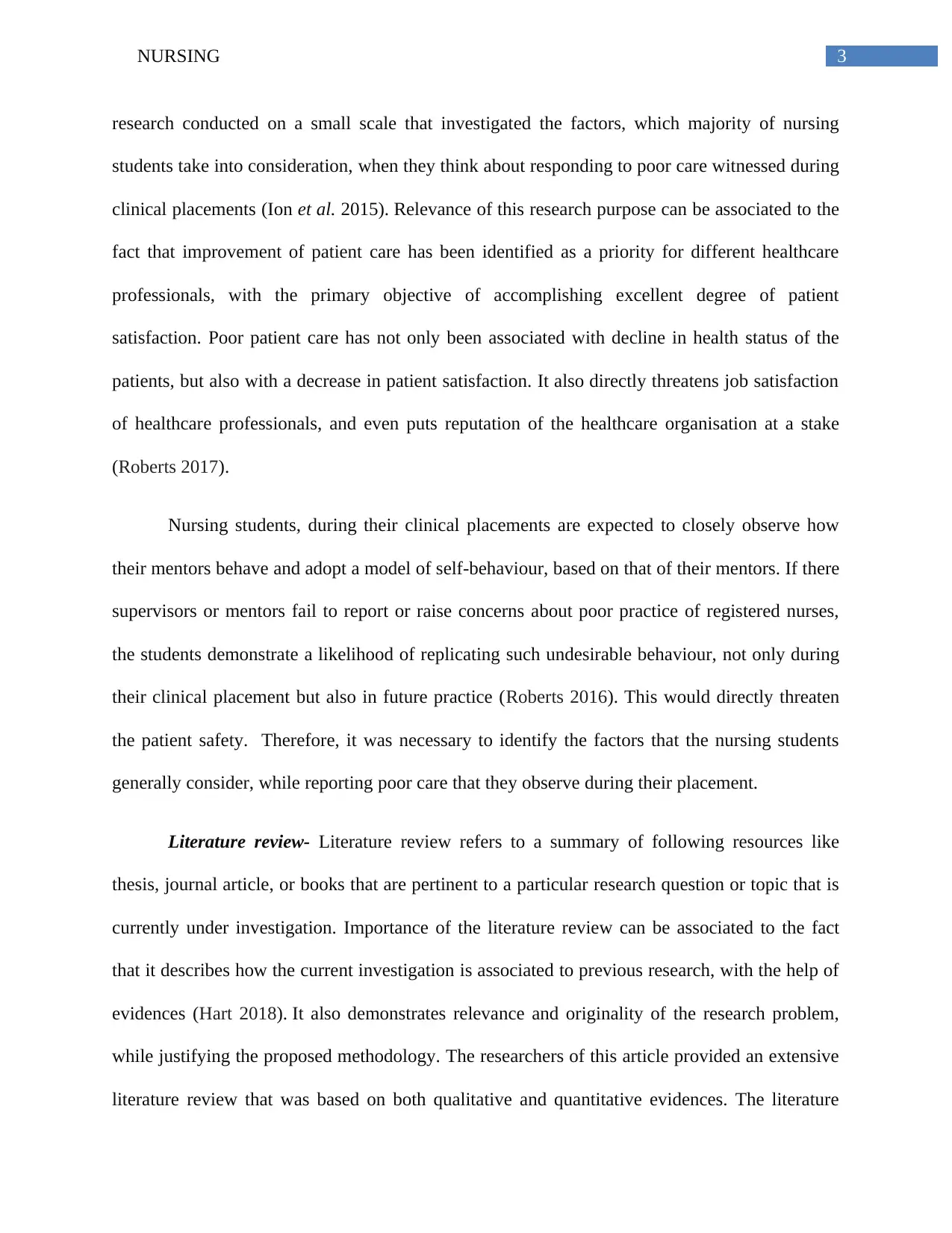
3NURSING
research conducted on a small scale that investigated the factors, which majority of nursing
students take into consideration, when they think about responding to poor care witnessed during
clinical placements (Ion et al. 2015). Relevance of this research purpose can be associated to the
fact that improvement of patient care has been identified as a priority for different healthcare
professionals, with the primary objective of accomplishing excellent degree of patient
satisfaction. Poor patient care has not only been associated with decline in health status of the
patients, but also with a decrease in patient satisfaction. It also directly threatens job satisfaction
of healthcare professionals, and even puts reputation of the healthcare organisation at a stake
(Roberts 2017).
Nursing students, during their clinical placements are expected to closely observe how
their mentors behave and adopt a model of self-behaviour, based on that of their mentors. If there
supervisors or mentors fail to report or raise concerns about poor practice of registered nurses,
the students demonstrate a likelihood of replicating such undesirable behaviour, not only during
their clinical placement but also in future practice (Roberts 2016). This would directly threaten
the patient safety. Therefore, it was necessary to identify the factors that the nursing students
generally consider, while reporting poor care that they observe during their placement.
Literature review- Literature review refers to a summary of following resources like
thesis, journal article, or books that are pertinent to a particular research question or topic that is
currently under investigation. Importance of the literature review can be associated to the fact
that it describes how the current investigation is associated to previous research, with the help of
evidences (Hart 2018). It also demonstrates relevance and originality of the research problem,
while justifying the proposed methodology. The researchers of this article provided an extensive
literature review that was based on both qualitative and quantitative evidences. The literature
research conducted on a small scale that investigated the factors, which majority of nursing
students take into consideration, when they think about responding to poor care witnessed during
clinical placements (Ion et al. 2015). Relevance of this research purpose can be associated to the
fact that improvement of patient care has been identified as a priority for different healthcare
professionals, with the primary objective of accomplishing excellent degree of patient
satisfaction. Poor patient care has not only been associated with decline in health status of the
patients, but also with a decrease in patient satisfaction. It also directly threatens job satisfaction
of healthcare professionals, and even puts reputation of the healthcare organisation at a stake
(Roberts 2017).
Nursing students, during their clinical placements are expected to closely observe how
their mentors behave and adopt a model of self-behaviour, based on that of their mentors. If there
supervisors or mentors fail to report or raise concerns about poor practice of registered nurses,
the students demonstrate a likelihood of replicating such undesirable behaviour, not only during
their clinical placement but also in future practice (Roberts 2016). This would directly threaten
the patient safety. Therefore, it was necessary to identify the factors that the nursing students
generally consider, while reporting poor care that they observe during their placement.
Literature review- Literature review refers to a summary of following resources like
thesis, journal article, or books that are pertinent to a particular research question or topic that is
currently under investigation. Importance of the literature review can be associated to the fact
that it describes how the current investigation is associated to previous research, with the help of
evidences (Hart 2018). It also demonstrates relevance and originality of the research problem,
while justifying the proposed methodology. The researchers of this article provided an extensive
literature review that was based on both qualitative and quantitative evidences. The literature
Paraphrase This Document
Need a fresh take? Get an instant paraphrase of this document with our AI Paraphraser
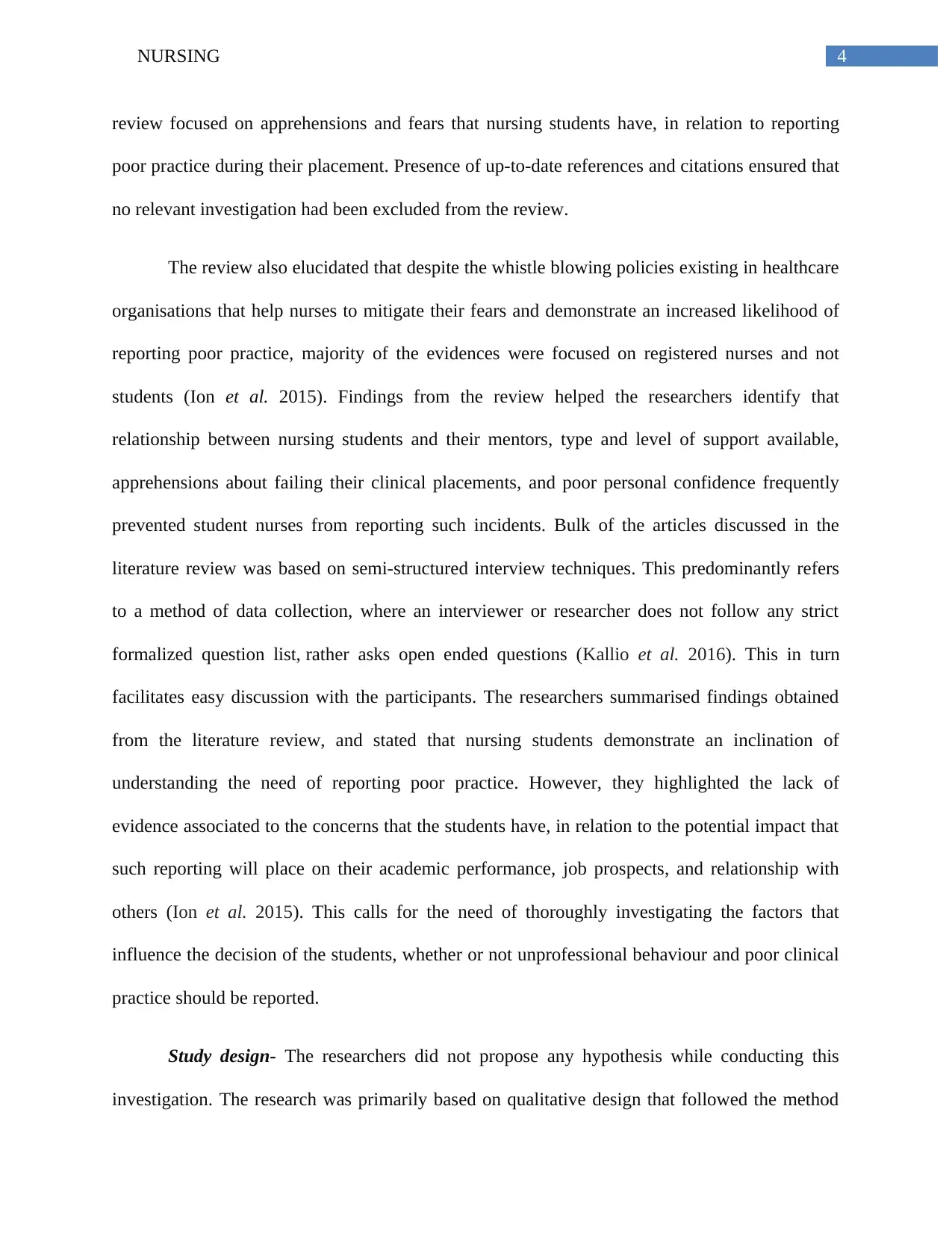
4NURSING
review focused on apprehensions and fears that nursing students have, in relation to reporting
poor practice during their placement. Presence of up-to-date references and citations ensured that
no relevant investigation had been excluded from the review.
The review also elucidated that despite the whistle blowing policies existing in healthcare
organisations that help nurses to mitigate their fears and demonstrate an increased likelihood of
reporting poor practice, majority of the evidences were focused on registered nurses and not
students (Ion et al. 2015). Findings from the review helped the researchers identify that
relationship between nursing students and their mentors, type and level of support available,
apprehensions about failing their clinical placements, and poor personal confidence frequently
prevented student nurses from reporting such incidents. Bulk of the articles discussed in the
literature review was based on semi-structured interview techniques. This predominantly refers
to a method of data collection, where an interviewer or researcher does not follow any strict
formalized question list, rather asks open ended questions (Kallio et al. 2016). This in turn
facilitates easy discussion with the participants. The researchers summarised findings obtained
from the literature review, and stated that nursing students demonstrate an inclination of
understanding the need of reporting poor practice. However, they highlighted the lack of
evidence associated to the concerns that the students have, in relation to the potential impact that
such reporting will place on their academic performance, job prospects, and relationship with
others (Ion et al. 2015). This calls for the need of thoroughly investigating the factors that
influence the decision of the students, whether or not unprofessional behaviour and poor clinical
practice should be reported.
Study design- The researchers did not propose any hypothesis while conducting this
investigation. The research was primarily based on qualitative design that followed the method
review focused on apprehensions and fears that nursing students have, in relation to reporting
poor practice during their placement. Presence of up-to-date references and citations ensured that
no relevant investigation had been excluded from the review.
The review also elucidated that despite the whistle blowing policies existing in healthcare
organisations that help nurses to mitigate their fears and demonstrate an increased likelihood of
reporting poor practice, majority of the evidences were focused on registered nurses and not
students (Ion et al. 2015). Findings from the review helped the researchers identify that
relationship between nursing students and their mentors, type and level of support available,
apprehensions about failing their clinical placements, and poor personal confidence frequently
prevented student nurses from reporting such incidents. Bulk of the articles discussed in the
literature review was based on semi-structured interview techniques. This predominantly refers
to a method of data collection, where an interviewer or researcher does not follow any strict
formalized question list, rather asks open ended questions (Kallio et al. 2016). This in turn
facilitates easy discussion with the participants. The researchers summarised findings obtained
from the literature review, and stated that nursing students demonstrate an inclination of
understanding the need of reporting poor practice. However, they highlighted the lack of
evidence associated to the concerns that the students have, in relation to the potential impact that
such reporting will place on their academic performance, job prospects, and relationship with
others (Ion et al. 2015). This calls for the need of thoroughly investigating the factors that
influence the decision of the students, whether or not unprofessional behaviour and poor clinical
practice should be reported.
Study design- The researchers did not propose any hypothesis while conducting this
investigation. The research was primarily based on qualitative design that followed the method
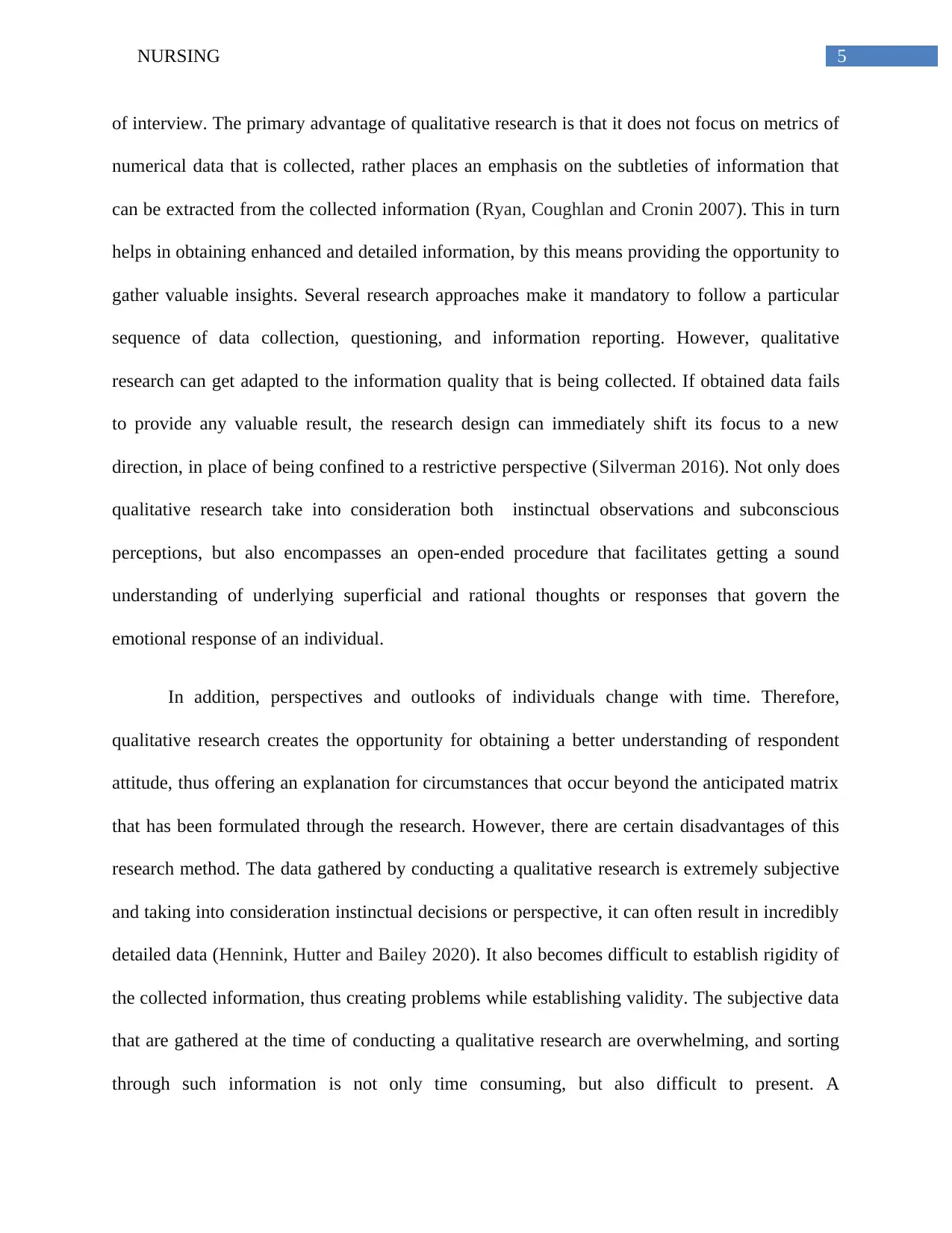
5NURSING
of interview. The primary advantage of qualitative research is that it does not focus on metrics of
numerical data that is collected, rather places an emphasis on the subtleties of information that
can be extracted from the collected information (Ryan, Coughlan and Cronin 2007). This in turn
helps in obtaining enhanced and detailed information, by this means providing the opportunity to
gather valuable insights. Several research approaches make it mandatory to follow a particular
sequence of data collection, questioning, and information reporting. However, qualitative
research can get adapted to the information quality that is being collected. If obtained data fails
to provide any valuable result, the research design can immediately shift its focus to a new
direction, in place of being confined to a restrictive perspective (Silverman 2016). Not only does
qualitative research take into consideration both instinctual observations and subconscious
perceptions, but also encompasses an open-ended procedure that facilitates getting a sound
understanding of underlying superficial and rational thoughts or responses that govern the
emotional response of an individual.
In addition, perspectives and outlooks of individuals change with time. Therefore,
qualitative research creates the opportunity for obtaining a better understanding of respondent
attitude, thus offering an explanation for circumstances that occur beyond the anticipated matrix
that has been formulated through the research. However, there are certain disadvantages of this
research method. The data gathered by conducting a qualitative research is extremely subjective
and taking into consideration instinctual decisions or perspective, it can often result in incredibly
detailed data (Hennink, Hutter and Bailey 2020). It also becomes difficult to establish rigidity of
the collected information, thus creating problems while establishing validity. The subjective data
that are gathered at the time of conducting a qualitative research are overwhelming, and sorting
through such information is not only time consuming, but also difficult to present. A
of interview. The primary advantage of qualitative research is that it does not focus on metrics of
numerical data that is collected, rather places an emphasis on the subtleties of information that
can be extracted from the collected information (Ryan, Coughlan and Cronin 2007). This in turn
helps in obtaining enhanced and detailed information, by this means providing the opportunity to
gather valuable insights. Several research approaches make it mandatory to follow a particular
sequence of data collection, questioning, and information reporting. However, qualitative
research can get adapted to the information quality that is being collected. If obtained data fails
to provide any valuable result, the research design can immediately shift its focus to a new
direction, in place of being confined to a restrictive perspective (Silverman 2016). Not only does
qualitative research take into consideration both instinctual observations and subconscious
perceptions, but also encompasses an open-ended procedure that facilitates getting a sound
understanding of underlying superficial and rational thoughts or responses that govern the
emotional response of an individual.
In addition, perspectives and outlooks of individuals change with time. Therefore,
qualitative research creates the opportunity for obtaining a better understanding of respondent
attitude, thus offering an explanation for circumstances that occur beyond the anticipated matrix
that has been formulated through the research. However, there are certain disadvantages of this
research method. The data gathered by conducting a qualitative research is extremely subjective
and taking into consideration instinctual decisions or perspective, it can often result in incredibly
detailed data (Hennink, Hutter and Bailey 2020). It also becomes difficult to establish rigidity of
the collected information, thus creating problems while establishing validity. The subjective data
that are gathered at the time of conducting a qualitative research are overwhelming, and sorting
through such information is not only time consuming, but also difficult to present. A
⊘ This is a preview!⊘
Do you want full access?
Subscribe today to unlock all pages.

Trusted by 1+ million students worldwide
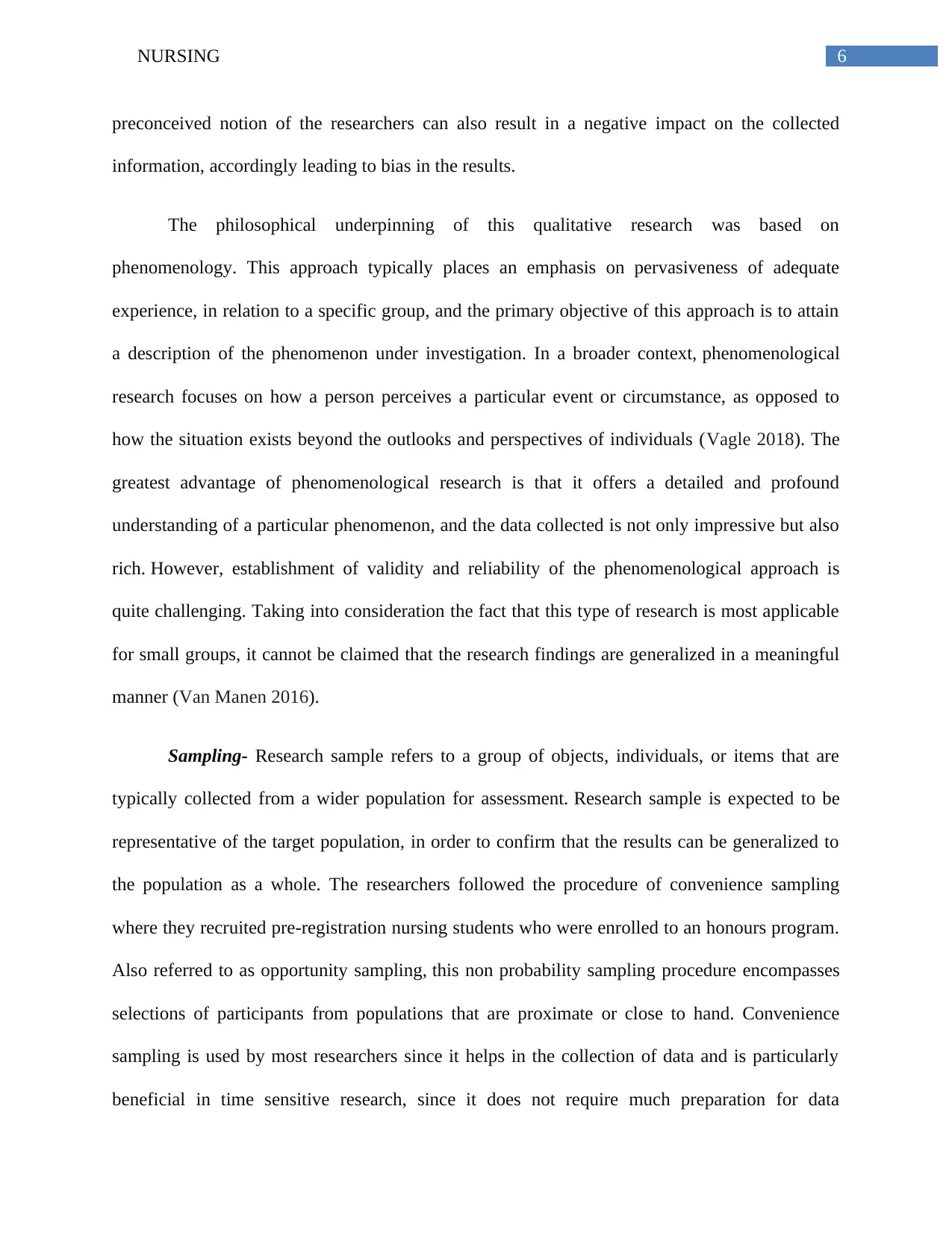
6NURSING
preconceived notion of the researchers can also result in a negative impact on the collected
information, accordingly leading to bias in the results.
The philosophical underpinning of this qualitative research was based on
phenomenology. This approach typically places an emphasis on pervasiveness of adequate
experience, in relation to a specific group, and the primary objective of this approach is to attain
a description of the phenomenon under investigation. In a broader context, phenomenological
research focuses on how a person perceives a particular event or circumstance, as opposed to
how the situation exists beyond the outlooks and perspectives of individuals (Vagle 2018). The
greatest advantage of phenomenological research is that it offers a detailed and profound
understanding of a particular phenomenon, and the data collected is not only impressive but also
rich. However, establishment of validity and reliability of the phenomenological approach is
quite challenging. Taking into consideration the fact that this type of research is most applicable
for small groups, it cannot be claimed that the research findings are generalized in a meaningful
manner (Van Manen 2016).
Sampling- Research sample refers to a group of objects, individuals, or items that are
typically collected from a wider population for assessment. Research sample is expected to be
representative of the target population, in order to confirm that the results can be generalized to
the population as a whole. The researchers followed the procedure of convenience sampling
where they recruited pre-registration nursing students who were enrolled to an honours program.
Also referred to as opportunity sampling, this non probability sampling procedure encompasses
selections of participants from populations that are proximate or close to hand. Convenience
sampling is used by most researchers since it helps in the collection of data and is particularly
beneficial in time sensitive research, since it does not require much preparation for data
preconceived notion of the researchers can also result in a negative impact on the collected
information, accordingly leading to bias in the results.
The philosophical underpinning of this qualitative research was based on
phenomenology. This approach typically places an emphasis on pervasiveness of adequate
experience, in relation to a specific group, and the primary objective of this approach is to attain
a description of the phenomenon under investigation. In a broader context, phenomenological
research focuses on how a person perceives a particular event or circumstance, as opposed to
how the situation exists beyond the outlooks and perspectives of individuals (Vagle 2018). The
greatest advantage of phenomenological research is that it offers a detailed and profound
understanding of a particular phenomenon, and the data collected is not only impressive but also
rich. However, establishment of validity and reliability of the phenomenological approach is
quite challenging. Taking into consideration the fact that this type of research is most applicable
for small groups, it cannot be claimed that the research findings are generalized in a meaningful
manner (Van Manen 2016).
Sampling- Research sample refers to a group of objects, individuals, or items that are
typically collected from a wider population for assessment. Research sample is expected to be
representative of the target population, in order to confirm that the results can be generalized to
the population as a whole. The researchers followed the procedure of convenience sampling
where they recruited pre-registration nursing students who were enrolled to an honours program.
Also referred to as opportunity sampling, this non probability sampling procedure encompasses
selections of participants from populations that are proximate or close to hand. Convenience
sampling is used by most researchers since it helps in the collection of data and is particularly
beneficial in time sensitive research, since it does not require much preparation for data
Paraphrase This Document
Need a fresh take? Get an instant paraphrase of this document with our AI Paraphraser
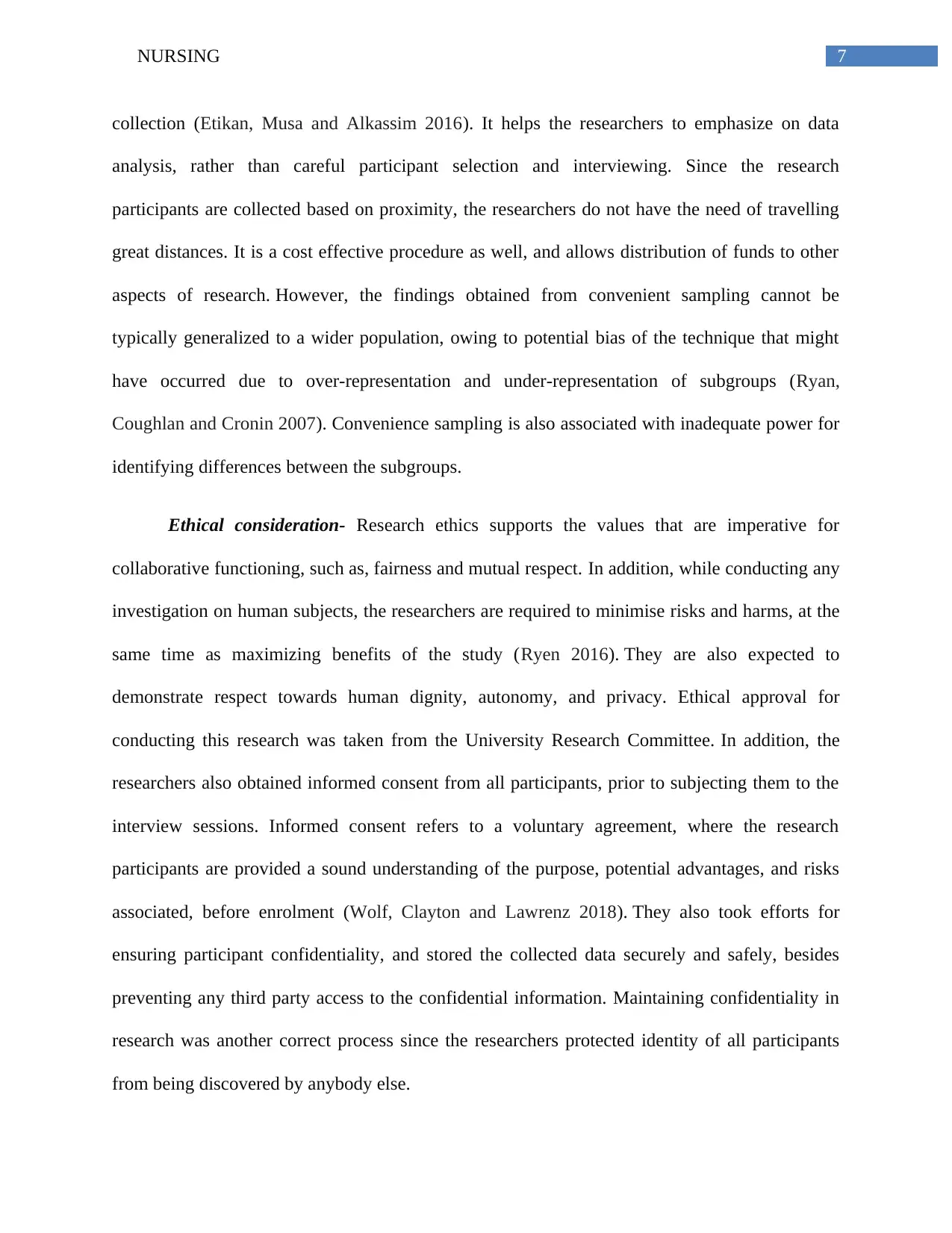
7NURSING
collection (Etikan, Musa and Alkassim 2016). It helps the researchers to emphasize on data
analysis, rather than careful participant selection and interviewing. Since the research
participants are collected based on proximity, the researchers do not have the need of travelling
great distances. It is a cost effective procedure as well, and allows distribution of funds to other
aspects of research. However, the findings obtained from convenient sampling cannot be
typically generalized to a wider population, owing to potential bias of the technique that might
have occurred due to over-representation and under-representation of subgroups (Ryan,
Coughlan and Cronin 2007). Convenience sampling is also associated with inadequate power for
identifying differences between the subgroups.
Ethical consideration- Research ethics supports the values that are imperative for
collaborative functioning, such as, fairness and mutual respect. In addition, while conducting any
investigation on human subjects, the researchers are required to minimise risks and harms, at the
same time as maximizing benefits of the study (Ryen 2016). They are also expected to
demonstrate respect towards human dignity, autonomy, and privacy. Ethical approval for
conducting this research was taken from the University Research Committee. In addition, the
researchers also obtained informed consent from all participants, prior to subjecting them to the
interview sessions. Informed consent refers to a voluntary agreement, where the research
participants are provided a sound understanding of the purpose, potential advantages, and risks
associated, before enrolment (Wolf, Clayton and Lawrenz 2018). They also took efforts for
ensuring participant confidentiality, and stored the collected data securely and safely, besides
preventing any third party access to the confidential information. Maintaining confidentiality in
research was another correct process since the researchers protected identity of all participants
from being discovered by anybody else.
collection (Etikan, Musa and Alkassim 2016). It helps the researchers to emphasize on data
analysis, rather than careful participant selection and interviewing. Since the research
participants are collected based on proximity, the researchers do not have the need of travelling
great distances. It is a cost effective procedure as well, and allows distribution of funds to other
aspects of research. However, the findings obtained from convenient sampling cannot be
typically generalized to a wider population, owing to potential bias of the technique that might
have occurred due to over-representation and under-representation of subgroups (Ryan,
Coughlan and Cronin 2007). Convenience sampling is also associated with inadequate power for
identifying differences between the subgroups.
Ethical consideration- Research ethics supports the values that are imperative for
collaborative functioning, such as, fairness and mutual respect. In addition, while conducting any
investigation on human subjects, the researchers are required to minimise risks and harms, at the
same time as maximizing benefits of the study (Ryen 2016). They are also expected to
demonstrate respect towards human dignity, autonomy, and privacy. Ethical approval for
conducting this research was taken from the University Research Committee. In addition, the
researchers also obtained informed consent from all participants, prior to subjecting them to the
interview sessions. Informed consent refers to a voluntary agreement, where the research
participants are provided a sound understanding of the purpose, potential advantages, and risks
associated, before enrolment (Wolf, Clayton and Lawrenz 2018). They also took efforts for
ensuring participant confidentiality, and stored the collected data securely and safely, besides
preventing any third party access to the confidential information. Maintaining confidentiality in
research was another correct process since the researchers protected identity of all participants
from being discovered by anybody else.
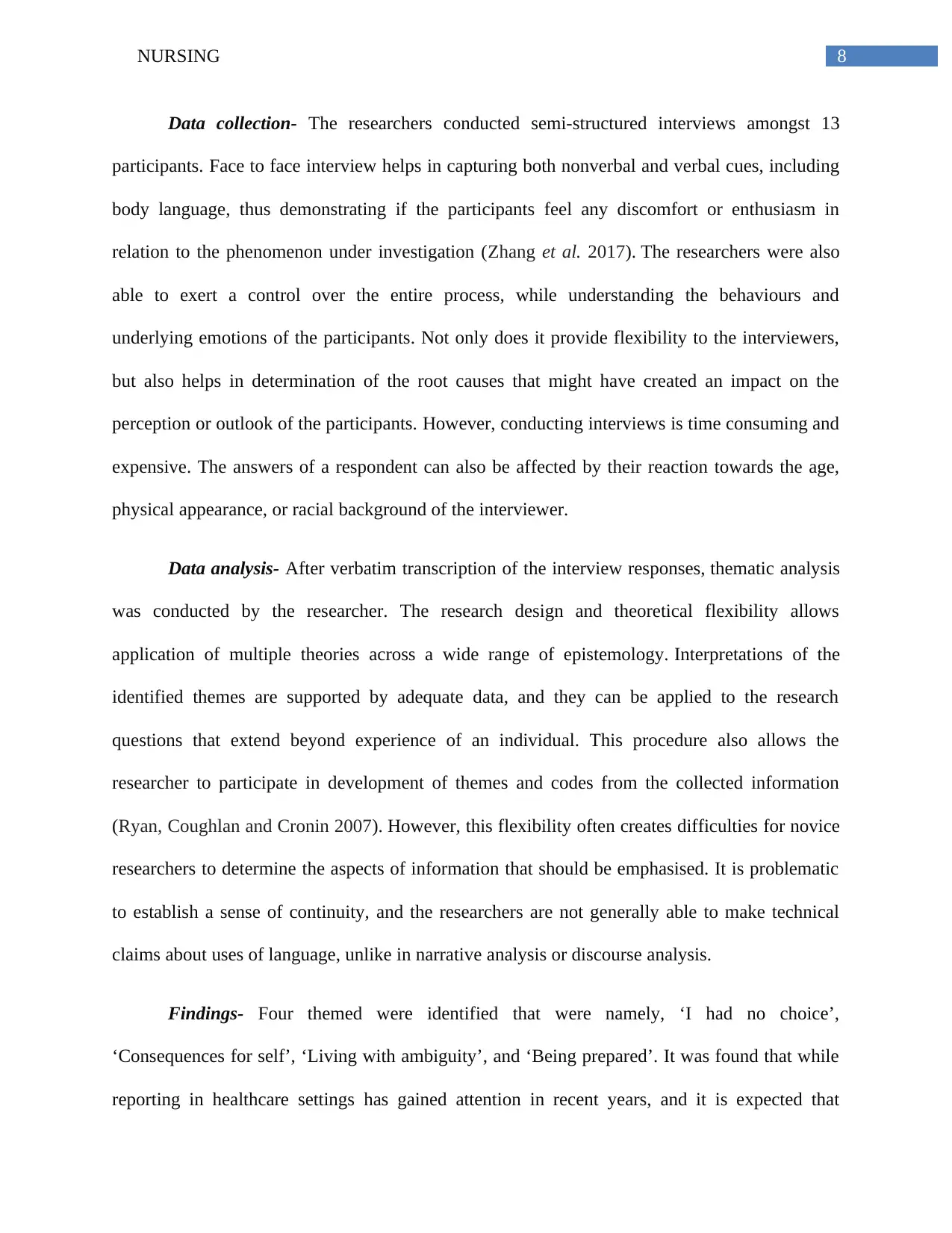
8NURSING
Data collection- The researchers conducted semi-structured interviews amongst 13
participants. Face to face interview helps in capturing both nonverbal and verbal cues, including
body language, thus demonstrating if the participants feel any discomfort or enthusiasm in
relation to the phenomenon under investigation (Zhang et al. 2017). The researchers were also
able to exert a control over the entire process, while understanding the behaviours and
underlying emotions of the participants. Not only does it provide flexibility to the interviewers,
but also helps in determination of the root causes that might have created an impact on the
perception or outlook of the participants. However, conducting interviews is time consuming and
expensive. The answers of a respondent can also be affected by their reaction towards the age,
physical appearance, or racial background of the interviewer.
Data analysis- After verbatim transcription of the interview responses, thematic analysis
was conducted by the researcher. The research design and theoretical flexibility allows
application of multiple theories across a wide range of epistemology. Interpretations of the
identified themes are supported by adequate data, and they can be applied to the research
questions that extend beyond experience of an individual. This procedure also allows the
researcher to participate in development of themes and codes from the collected information
(Ryan, Coughlan and Cronin 2007). However, this flexibility often creates difficulties for novice
researchers to determine the aspects of information that should be emphasised. It is problematic
to establish a sense of continuity, and the researchers are not generally able to make technical
claims about uses of language, unlike in narrative analysis or discourse analysis.
Findings- Four themed were identified that were namely, ‘I had no choice’,
‘Consequences for self’, ‘Living with ambiguity’, and ‘Being prepared’. It was found that while
reporting in healthcare settings has gained attention in recent years, and it is expected that
Data collection- The researchers conducted semi-structured interviews amongst 13
participants. Face to face interview helps in capturing both nonverbal and verbal cues, including
body language, thus demonstrating if the participants feel any discomfort or enthusiasm in
relation to the phenomenon under investigation (Zhang et al. 2017). The researchers were also
able to exert a control over the entire process, while understanding the behaviours and
underlying emotions of the participants. Not only does it provide flexibility to the interviewers,
but also helps in determination of the root causes that might have created an impact on the
perception or outlook of the participants. However, conducting interviews is time consuming and
expensive. The answers of a respondent can also be affected by their reaction towards the age,
physical appearance, or racial background of the interviewer.
Data analysis- After verbatim transcription of the interview responses, thematic analysis
was conducted by the researcher. The research design and theoretical flexibility allows
application of multiple theories across a wide range of epistemology. Interpretations of the
identified themes are supported by adequate data, and they can be applied to the research
questions that extend beyond experience of an individual. This procedure also allows the
researcher to participate in development of themes and codes from the collected information
(Ryan, Coughlan and Cronin 2007). However, this flexibility often creates difficulties for novice
researchers to determine the aspects of information that should be emphasised. It is problematic
to establish a sense of continuity, and the researchers are not generally able to make technical
claims about uses of language, unlike in narrative analysis or discourse analysis.
Findings- Four themed were identified that were namely, ‘I had no choice’,
‘Consequences for self’, ‘Living with ambiguity’, and ‘Being prepared’. It was found that while
reporting in healthcare settings has gained attention in recent years, and it is expected that
⊘ This is a preview!⊘
Do you want full access?
Subscribe today to unlock all pages.

Trusted by 1+ million students worldwide
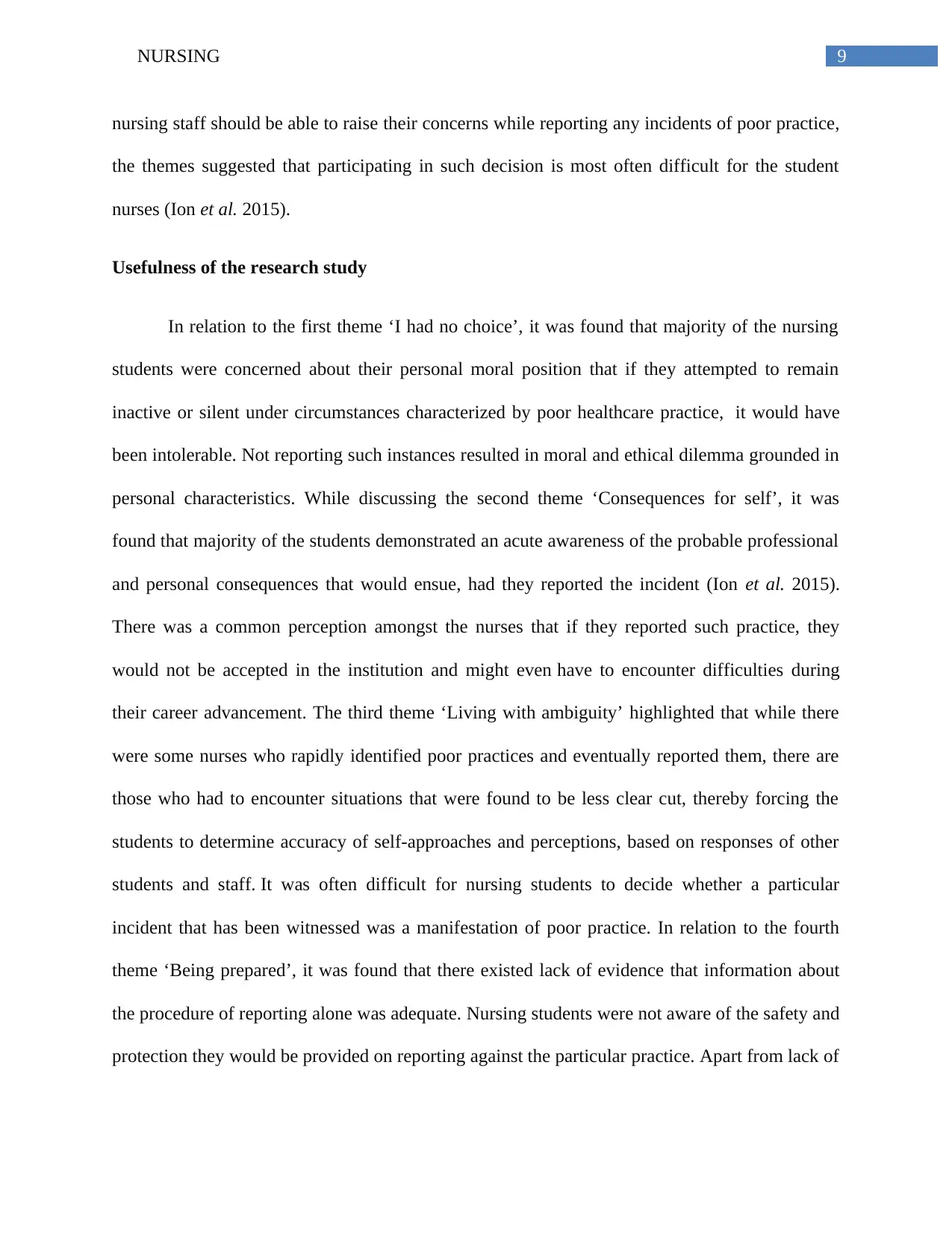
9NURSING
nursing staff should be able to raise their concerns while reporting any incidents of poor practice,
the themes suggested that participating in such decision is most often difficult for the student
nurses (Ion et al. 2015).
Usefulness of the research study
In relation to the first theme ‘I had no choice’, it was found that majority of the nursing
students were concerned about their personal moral position that if they attempted to remain
inactive or silent under circumstances characterized by poor healthcare practice, it would have
been intolerable. Not reporting such instances resulted in moral and ethical dilemma grounded in
personal characteristics. While discussing the second theme ‘Consequences for self’, it was
found that majority of the students demonstrated an acute awareness of the probable professional
and personal consequences that would ensue, had they reported the incident (Ion et al. 2015).
There was a common perception amongst the nurses that if they reported such practice, they
would not be accepted in the institution and might even have to encounter difficulties during
their career advancement. The third theme ‘Living with ambiguity’ highlighted that while there
were some nurses who rapidly identified poor practices and eventually reported them, there are
those who had to encounter situations that were found to be less clear cut, thereby forcing the
students to determine accuracy of self-approaches and perceptions, based on responses of other
students and staff. It was often difficult for nursing students to decide whether a particular
incident that has been witnessed was a manifestation of poor practice. In relation to the fourth
theme ‘Being prepared’, it was found that there existed lack of evidence that information about
the procedure of reporting alone was adequate. Nursing students were not aware of the safety and
protection they would be provided on reporting against the particular practice. Apart from lack of
nursing staff should be able to raise their concerns while reporting any incidents of poor practice,
the themes suggested that participating in such decision is most often difficult for the student
nurses (Ion et al. 2015).
Usefulness of the research study
In relation to the first theme ‘I had no choice’, it was found that majority of the nursing
students were concerned about their personal moral position that if they attempted to remain
inactive or silent under circumstances characterized by poor healthcare practice, it would have
been intolerable. Not reporting such instances resulted in moral and ethical dilemma grounded in
personal characteristics. While discussing the second theme ‘Consequences for self’, it was
found that majority of the students demonstrated an acute awareness of the probable professional
and personal consequences that would ensue, had they reported the incident (Ion et al. 2015).
There was a common perception amongst the nurses that if they reported such practice, they
would not be accepted in the institution and might even have to encounter difficulties during
their career advancement. The third theme ‘Living with ambiguity’ highlighted that while there
were some nurses who rapidly identified poor practices and eventually reported them, there are
those who had to encounter situations that were found to be less clear cut, thereby forcing the
students to determine accuracy of self-approaches and perceptions, based on responses of other
students and staff. It was often difficult for nursing students to decide whether a particular
incident that has been witnessed was a manifestation of poor practice. In relation to the fourth
theme ‘Being prepared’, it was found that there existed lack of evidence that information about
the procedure of reporting alone was adequate. Nursing students were not aware of the safety and
protection they would be provided on reporting against the particular practice. Apart from lack of
Paraphrase This Document
Need a fresh take? Get an instant paraphrase of this document with our AI Paraphraser
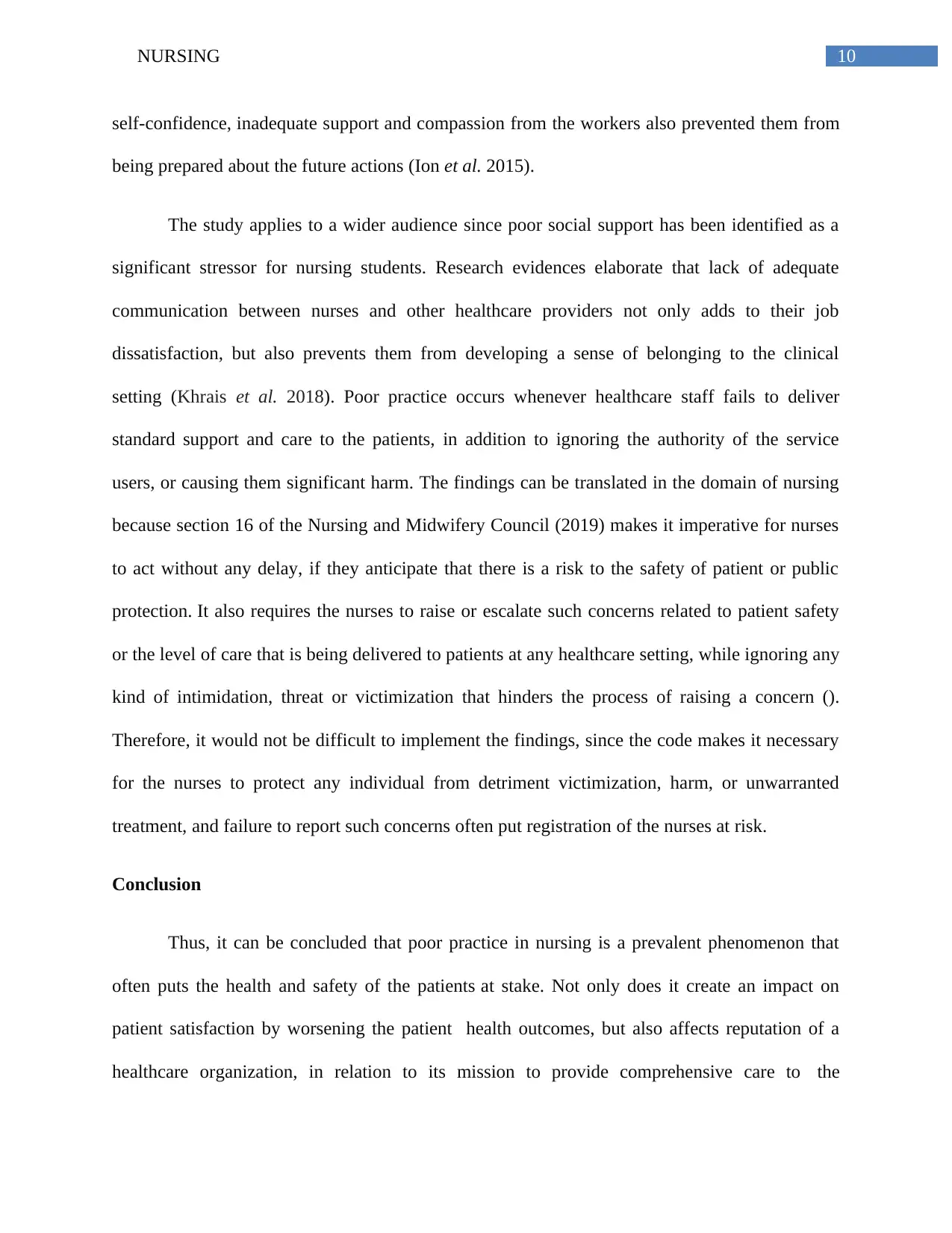
10NURSING
self-confidence, inadequate support and compassion from the workers also prevented them from
being prepared about the future actions (Ion et al. 2015).
The study applies to a wider audience since poor social support has been identified as a
significant stressor for nursing students. Research evidences elaborate that lack of adequate
communication between nurses and other healthcare providers not only adds to their job
dissatisfaction, but also prevents them from developing a sense of belonging to the clinical
setting (Khrais et al. 2018). Poor practice occurs whenever healthcare staff fails to deliver
standard support and care to the patients, in addition to ignoring the authority of the service
users, or causing them significant harm. The findings can be translated in the domain of nursing
because section 16 of the Nursing and Midwifery Council (2019) makes it imperative for nurses
to act without any delay, if they anticipate that there is a risk to the safety of patient or public
protection. It also requires the nurses to raise or escalate such concerns related to patient safety
or the level of care that is being delivered to patients at any healthcare setting, while ignoring any
kind of intimidation, threat or victimization that hinders the process of raising a concern ().
Therefore, it would not be difficult to implement the findings, since the code makes it necessary
for the nurses to protect any individual from detriment victimization, harm, or unwarranted
treatment, and failure to report such concerns often put registration of the nurses at risk.
Conclusion
Thus, it can be concluded that poor practice in nursing is a prevalent phenomenon that
often puts the health and safety of the patients at stake. Not only does it create an impact on
patient satisfaction by worsening the patient health outcomes, but also affects reputation of a
healthcare organization, in relation to its mission to provide comprehensive care to the
self-confidence, inadequate support and compassion from the workers also prevented them from
being prepared about the future actions (Ion et al. 2015).
The study applies to a wider audience since poor social support has been identified as a
significant stressor for nursing students. Research evidences elaborate that lack of adequate
communication between nurses and other healthcare providers not only adds to their job
dissatisfaction, but also prevents them from developing a sense of belonging to the clinical
setting (Khrais et al. 2018). Poor practice occurs whenever healthcare staff fails to deliver
standard support and care to the patients, in addition to ignoring the authority of the service
users, or causing them significant harm. The findings can be translated in the domain of nursing
because section 16 of the Nursing and Midwifery Council (2019) makes it imperative for nurses
to act without any delay, if they anticipate that there is a risk to the safety of patient or public
protection. It also requires the nurses to raise or escalate such concerns related to patient safety
or the level of care that is being delivered to patients at any healthcare setting, while ignoring any
kind of intimidation, threat or victimization that hinders the process of raising a concern ().
Therefore, it would not be difficult to implement the findings, since the code makes it necessary
for the nurses to protect any individual from detriment victimization, harm, or unwarranted
treatment, and failure to report such concerns often put registration of the nurses at risk.
Conclusion
Thus, it can be concluded that poor practice in nursing is a prevalent phenomenon that
often puts the health and safety of the patients at stake. Not only does it create an impact on
patient satisfaction by worsening the patient health outcomes, but also affects reputation of a
healthcare organization, in relation to its mission to provide comprehensive care to the
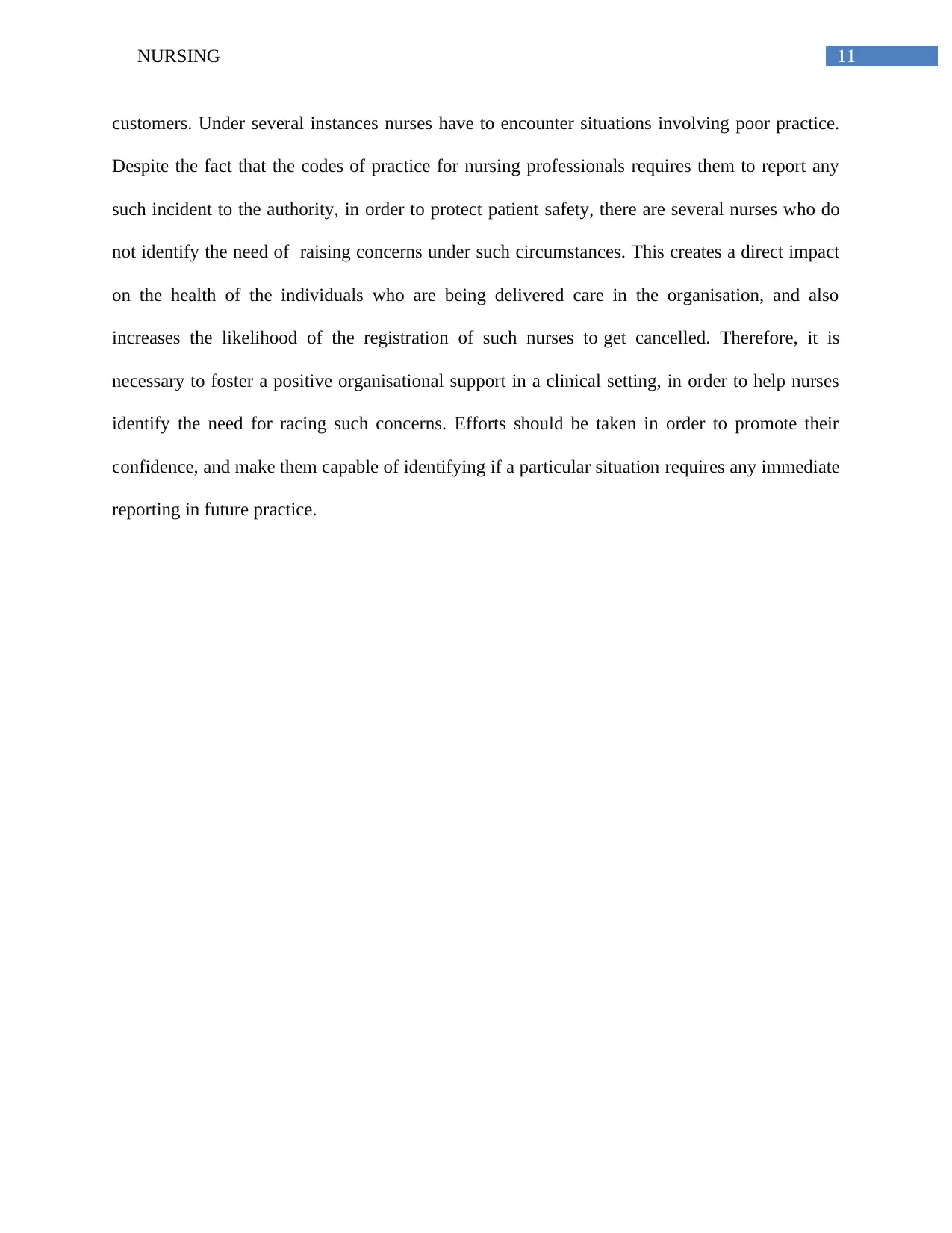
11NURSING
customers. Under several instances nurses have to encounter situations involving poor practice.
Despite the fact that the codes of practice for nursing professionals requires them to report any
such incident to the authority, in order to protect patient safety, there are several nurses who do
not identify the need of raising concerns under such circumstances. This creates a direct impact
on the health of the individuals who are being delivered care in the organisation, and also
increases the likelihood of the registration of such nurses to get cancelled. Therefore, it is
necessary to foster a positive organisational support in a clinical setting, in order to help nurses
identify the need for racing such concerns. Efforts should be taken in order to promote their
confidence, and make them capable of identifying if a particular situation requires any immediate
reporting in future practice.
customers. Under several instances nurses have to encounter situations involving poor practice.
Despite the fact that the codes of practice for nursing professionals requires them to report any
such incident to the authority, in order to protect patient safety, there are several nurses who do
not identify the need of raising concerns under such circumstances. This creates a direct impact
on the health of the individuals who are being delivered care in the organisation, and also
increases the likelihood of the registration of such nurses to get cancelled. Therefore, it is
necessary to foster a positive organisational support in a clinical setting, in order to help nurses
identify the need for racing such concerns. Efforts should be taken in order to promote their
confidence, and make them capable of identifying if a particular situation requires any immediate
reporting in future practice.
⊘ This is a preview!⊘
Do you want full access?
Subscribe today to unlock all pages.

Trusted by 1+ million students worldwide
1 out of 15
Related Documents
Your All-in-One AI-Powered Toolkit for Academic Success.
+13062052269
info@desklib.com
Available 24*7 on WhatsApp / Email
![[object Object]](/_next/static/media/star-bottom.7253800d.svg)
Unlock your academic potential
Copyright © 2020–2025 A2Z Services. All Rights Reserved. Developed and managed by ZUCOL.





